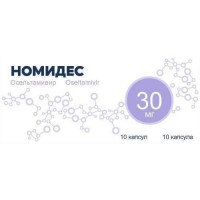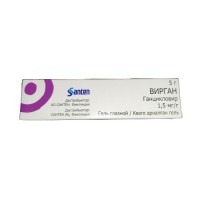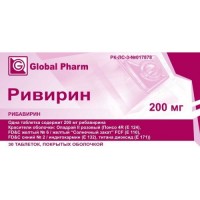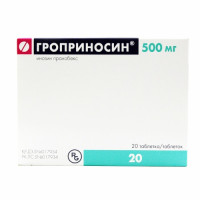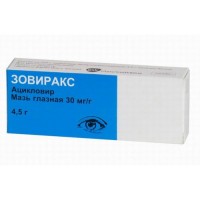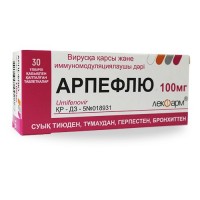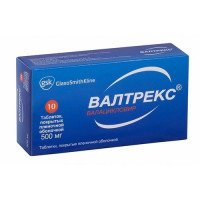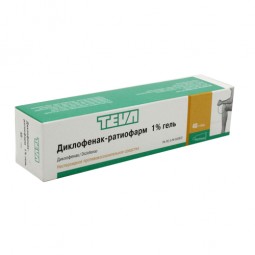Acyclovir-SHS 200 mg (20 tablets)
- $2.90
Instruction for medical use of ATSIKLOVIR-SVS medicine Trade name Acyclovir - SVS the International unlicensed name Acyclovir Dosage Form of the Tablet of 0.2 g Structure One tablet contains active agent – acyclovir of 0.2 g, excipients: lactoses monohydrate, magnesium stearate, corn starch, sodium of a kroskarmelloz the Description of the Tablet of white or almost white color of a ploskotsilindrichesky form with a facet Pharmacotherapeutic group. Antiviral drugs for system use. Antiviral drugs of direct action. Nucleosides and nucleotides. Acyclovir the ATX J05AB01 Code the Pharmacological Pharmacokinetics Later properties of intake drug is only partially absorbed from intestines. Administration of drug along with food influences its absorption a little. The bioavailability is 15―30%. Concentration in blood depends on the accepted dose. Linking with proteins makes 9―30%. Drug is widely distributed in fabrics and liquids of an organism, including a brain, kidneys, lungs, a liver, plaintive liquid, intestines, muscle tissue, a spleen, sperm, secretion and a mucous membrane of a vagina, a uterus, breast milk, amniotic liquid, contents of herpetic bubbles. The highest concentrations are found in kidneys, a liver and intestines. Concentration in cerebrospinal fluid makes about 50% of concentration in blood plasma. At oral administration of drug of 1 g a day the concentration in breast milk can exceed its concentration in plasma by 0.6 - 4.1 times, in amniotic liquid ― by 3―6 times, in such cases with mother's milk acyclovir comes to the child's organism in a dose of 0.0003 g/kg a day. Therefore, the feeding women need to appoint drug with care. Long or repeated rates of drug at patients with reduced immunity can lead to emergence of the virus strains insensitive to acyclovir. It can be caused by deficit of a virus thymidinekinase or change of structure of a thymidinekinase and DNA polymerase. A natural metabolite of acyclovir is 9-karboksimetoksimetilguanin. Elimination half-life at intake at adults – 3.3 h. Time of achievement of the maximum concentration in blood serum at oral administration ― 7.7 h. Average maximum concentration in blood serum (stable) at intake at adults such: at a dose of 0.2 g (2.5 µmol/l) each 4 h ― 0.6 mkg/ml, at a dose of 0.4 g (5.3 µmol/l) each 4 h ― 1.2 mkg/ml, at a dose of 0.8 g (6.9 µmol/l) each 4 h ― 1.6 mkg/ml. The volume of distribution (Vold) (at achievement of stable concentration): adults: about 48 l/sq.m of a body surface (37―57 l/sq.m), children and teenagers (1―18 years): about 45 l/sq.m. In a disease of kidneys in an end-stage: about 41 l/sq.m. At intake about 14% of the general dose the most part of drug is removed in not changed view with urine, – in the form of metabolites, an insignificant part is removed with a stake. In the course of removal of drug along with glomerular filtration the mechanism of canalicular secretion participates, apparently. Drug clearance rate from an organism slows down with age though irrespective of it elimination half-life of drug increases slightly. In chronic kidney disease the value of elimination half-life averages 19.5 h. In case of a hemodialysis this rate is 5.7 h, at the same time concentration of drug in plasma decreases up to 60% of a reference value (at a single 6-hour session). At peritoneal dialysis the clearance of drug considerably does not change. A pharmacodynamics Acyclovir - SVS ― antiviral drug, is highly active concerning a virus of a herpes simplex (Herpes simplex (VHS)) of type 1 and 2, a virus of shingles (Varicella zoster (VZV)), a virus of chicken pox, Epstein's virus - Burra and to a lesser extent - a cytomegalovirus. Acyclovir – SVS is a synthetic analog of a purine nucleoside - a dezoksiguanidina. After implementation of acyclovir in the cell affected with a virus under the influence of the enzyme of a thymidinekinase emitted by a virus, acyclovir passes into acyclovir-monophosphate. At action of a cellular guanilatkinaza, acyclovir-monophosphate will be transformed to acyclovir-diphosphate which enzymes of a host cell (virus) turns into an active form – acyclovir-triphosphate. Interacting with a DNA polymerase (VHS and VZV), suppresses replication of virus DNA. By means of a virus DNA polymerase, acyclovir-triphosphate can be built in the growing DNA chains therefore in a chain of DNA the defect appears and growth of new generation of viruses stops. Drug has sharp selectivity of action on synthesis of virus DNA. Triphosphate acyclovir inclusion in a chain of virus DNA and the subsequent break of a chain block further replication of virus DNA. At patients with the expressed immunodeficiency the long or repeated courses of therapy by acyclovir can lead to formation of resistant strains and therefore further treatment by Acyclovir - SVS can be inefficient. Indications. treatment and prevention of genital herpes: primary cases and recurrent heavy herpes at patients with the kept or weakened immunity treatment and prevention of the herpes simplex caused by 1 and 2 viruses (VHS-1 and VHS-2) – primary and recuring with damage of skin and mucous membranes, including the patients after transplantation receiving immunosuppressive means in HIV infection, when carrying out chemotherapy at patients with the kept or weakened immunity the surrounding herpes at adult patients chicken pox at patients with the weakened immunity Acyclovir - SVS appoint the Route of administration and doses inside. Treatment should be begun at emergence of the first signs and symptoms of a herpes simplex or infections caused by VZV. Treatment of chicken pox is most effective if it is begun in the first or second day after appearance of rash. Patients with the broken immunity for healing have damages of skin and mucous membranes duration of therapy can be increased, before emergence of strup or epithelization. Acyclovir – SVS can be accepted at meal time since it practically does not influence absorption. It is recommended to wash down with a glass of water. For some patients there can be effective a faltering short-term treatment of recurrent herpes of genitals, but treatment needs to be begun during a prodromal stage or at the first symptoms of a disease. Average doses for adults and children since 6 years: Treatment of genital herpes (primary infection): on 200 mg of 5 times a day within 10 days. The course of treatment and further tactics are defined individually. To patients with reduced immunity, including after organ transplantation or marrow appoint 400 mg of 5 times a day. A course of treatment ― not less than 5 days, if necessary ―10 days, - recurrent infections, faltering therapy: on 200 mg of 5 times a day within 5 days, - recurrent infections, long overwhelming therapy: on 400 mg 2 times a day or on 200 mg of 3―5 times a day, Treatment of a herpes simplex with damage of skin and mucous membranes: on 200 5 times a day within 10 days. In case of the expressed immunodeficiency or at disturbance of absorption from intestines the dose can be an uchelichena up to 400 mg of 5 times a day, Prevention of a herpes simplex with damage of skin and mucous membranes: on 400 mg each 12 h. Duration of a preventive course is defined by risk period duration, the Surrounding herpes: on 800 mg of 5 times a day within 7―10 days. For patients with a pronounced immunodeficiency it is necessary to think over option of intravenous administration, Treatment is most effective if to begin it during 48 h after appearance of rash. Chicken pox: on 800 mg 4 times a day within 5 days. Treatment should be begun at emergence of the first signs or symptoms of chicken pox during 24 h (after appearance of typical rash). Children to Children are younger than 6 years prescribing of drug is not recommended. Treatment of the infections caused by a herpes simplex virus - children is more senior than 6 years: On 200 mg (1 tablet) of 5 times a day (each 4 hours), except for the period of night sleep. The course of treatment makes 5 days. In case of the expressed immunodeficiency (for example, after bone marrow transplantation) or at disturbance of absorption from intestines the dose can be increased up to 400 mg of 5 times a day. Prevention of the infections caused by a herpes simplex virus in children with an immunodeficiency - children is more senior than 6 years: On 200 mg 4 times a day (each 6 hours). In case of the expressed immunodeficiency - on 200 mg of 5 times a day. Treatment of chicken pox - children is more senior than 6 years: 800 mg 4 times a day More precisely a dose can be defined at the rate of 20 mg/kg of body weight (but no more than 800 mg) 4 times a day. The course of treatment makes 5 days. The maximum single dose – 800 mg. The maximum daily dose – 4000 mg. Side effects Often - a headache, dizziness - an itching, rash, a photosensitization - fast fatigue, temperature increase Infrequently - a small tortoiseshell - a fast diffusion hair loss (alopecia) Seldom - an anaphylaxis, a Quincke's disease, an asthma - reversible increase in level of bilirubin and activity of enzymes of a liver - increase in concentration of urea and creatinine in blood Is very rare - an acute renal failure - anemia, a leukopenia and thrombocytopenia - a disturbing state, a tremor, an ataxy, a dysarthtia, hallucinations, psychotic symptoms, convulsions, drowsiness, encephalopathy, a coma (these side effects were observed at patients with a renal failure who took the drug in the doses exceeding recommended) - hepatitis, Contraindication jaundice - hypersensitivity to acyclovir or to any auxiliary component of drug - pregnancy and the period of a lactation - children's age up to 6 years - a hereditary lactose intolerance or hereditary nedostatochnostlaktaza, malabsorption of a glucose/galactose Medicinal interactions At simultaneous use of Acyclovir - SVS with other nephrotoxic drugs amplifies nephrotoxic action of the last, especially in renal failures. At combined use of Acyclovir – SVS and the probenitsida decreases canalicular secretion of acyclovir, elimination half-life and its concentration in blood serum and cerebrospinal fluid increases. The concomitant use of Acyclovir – SVS and a zidovudine in HIV infections does not influence kinetics of these drugs. Special instructions At long administration of drug in the recommended doses at patients with impaired renal function the accumulation of acyclovir above safe level was not observed. At use of high doses, acyclovir crystals in renal tubules are extremely seldom formed. In this case it is necessary to increase liquid consumption. During treatment it is necessary to control function of kidneys (determination of level of urea nitrogen in blood and creatinine in blood plasma). If at women with herpes of genitals for the 1st week the state does not improve, it is necessary to perform gynecologic examination (at patients with herpes of genitals the risk of developing cervical cancer therefore it is necessary to carry out the Papanikolau test for definition of initial changes of a neck of the uterus once a year is increased). At treatment of genital herpes it is necessary to avoid sexual contacts. In chicken pox the therapy is more effective if to begin it for 24 h after manifestation of a rash, typical for it. At use of drug there can be a moderate short-term increase in level of bilirubin and enzymes of a liver, in isolated cases ― increase in concentration of urea and creatinine in blood, insignificant deterioration in hematologic indicators. The feature of influence of medicine on ability to run the vehicle or potentially dangerous mechanisms At use of drug should be careful during the driving and work with potentially dangerous mechanisms demanding the increased concentration of attention and speed of psychomotor reactions. Overdose Symptoms: headache, nausea, vomiting, diarrhea, short wind, renal failure, lethargy, spasms, coma. Treatment As there is no specific antidote, treatment of adverse effects or overdose has to be symptomatic and supporting. Carrying out a hemodialysis, especially at patients with an acute renal failure is recommended. It is necessary to increase intake of liquid in an organism for prevention of formation of crystals in renal tubules. A form of release and packing On 10 tablets in blister strip packaging from a film of the polyvinylchloride or printing aluminum foil varnished. On the 2nd blister strip packagings together with the instruction for use in the state and Russian languages place in a pack from cardboard. To Store storage conditions in the dry, protected from light place at a temperature not above 25 °C. To store out of children's reach! 3 years not to apply a period of storage after the expiration date specified on packing. Prescription status According to the prescription SVS — Pharmation LLP Producer, Legal address: 030012 Republic of Kazakhstan, Aktobe, Sankibay Ave of the batyr 171, B the location Address: 030003 Republic of Kazakhstan, Aktobe, Aviagorodok, 14. ph. +7 7132 227755 info@svspharmacy.kz the Address of the organization accepting in the territory of the Republic of Kazakhstan claims from consumers on quality of products (goods) of SVS — Pharmation LLP Legal address: 030012 Republic of Kazakhstan, Aktobe, Sankibay Ave of the batyr 171, B the location Address: 030003 Republic of Kazakhstan Aktobe, Aviagorodok, 14.
To develop
To develop

